How to put on a leash for cats. What material is better to buy a harness from? How to properly put a collar on a cat?
Despite the fact that cats have long been domestic animals, and most of them are “exclusively domestic”, the need for fresh air and they still had some for walks.
In addition to the warm sun and green grass, walks add variety to a cat’s life and provide an opportunity to expand the boundaries of her world. However, walking independently in unfamiliar territory, especially in big city, can be very dangerous (aggressive dogs, vehicles, etc.). An excellent solution to this problem can be a harness for cats, which will allow the animal to walk relatively freely, but under the supervision of the owner.
Types of harnesses for cats
The stores offer a wide range of cat harnesses various types, styles and colors. The most common:
• figure-eight harnesses (consist of two loops that cover the cat’s body at the neck and just behind the front paws, connecting at the shoulder blades. This design eliminates the possibility of the cat “slipping out” and prevents the possibility of suffocation);
• H-shaped harnesses (similar to the previous ones, only on the back the loops have a connecting bar, which makes the harnesses look like the letter H);
• V-shaped harnesses (the loop forms a V on the chest);
• harnesses and jackets (among other things, they help protect the fur from dirt and cold).



How to choose the right harness for a cat
When choosing, you should pay attention to the following factors:
• Material. Harnesses made of cotton or nylon are more often chosen, as they are easy to clean and do not rub the animal’s skin. Leather harnesses are not particularly popular, as they are stiffer and heavier.
• Width of straps. 1-1.5 cm are considered optimal. It is desirable to be able to change the length of the straps.
• Fastenings. Should be secure and easy to fasten and unfasten. There are models with a detachable leash, which is very convenient for long walks. In this case, you can choose a longer and more convenient leash in the form of a tape measure.
• Size. Determined by the circumference of the chest behind the front legs. By inserting 2 fingers between the harness and the cat's back, you can check that the purchased harness is the correct size. If your fingers fit freely, then the size is correct.
It is also worth choosing a leash. They come in regular and roulette form. Roulette allows you to provide more freedom pet, but may have more weight, which not all cats will like.
How to properly put a harness on a cat.
Putting a harness on a cat for the first time can be quite difficult, but with some experience and skill it will only take a few seconds.
How to properly put a harness on a cat
So, you need to complete the following points:
1. Check if the harness is adjusted to the correct size. At first, you can unfasten the leash so that it doesn’t get tangled or interfere.
2. Pick up the cat and calm it down by petting and talking to it.
3. Place a closed ring around the cat’s neck, turning it so that the carabiner is on the back. Then we insert the front paws one by one into the second ring. If the harness has a clasp, then we insert one paw into the triangle between the closed ring, the jumper and the clasp, and place the strap with the clasp under the belly and fasten it on the back, so that the second paw is in a similar triangle.
4. Check that all carabiners are fastened and that there are no bends or creases on the straps.
5. Make sure that the cat’s harness does not press or pinch. Adjust the straps if necessary.
6. Attach the leash to the carabiner.
Now the cat is ready for a walk. However, it is very rare that animals immediately calmly accept a harness; most often they need to be prepared for this device.
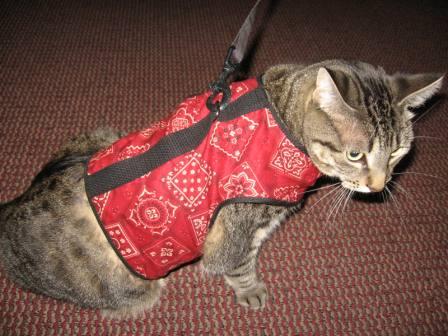



How to train a cat to wear a harness
After purchasing the equipment, you can begin to train your cat to wear a harness, which is not always easy. It is best to teach it from childhood. You can start wearing a harness from 2-3 months of age. You should not immediately try to put a harness on a cat, as the animal may be frightened by an unfamiliar object and the training process may take a long time. First you need to let the cat sniff new thing, to meet her. Then the harness should be placed near the places where the cat likes to spend time (sleeping, playing, eating). After a few days, you can put on the harness without the leash at first. Some cats take the new device calmly the first time, while some may begin to break free and try to remove the harness.
accustoming the cat to a harness and fresh air
In this case, you should try to calm and distract the animal with play or food. If all else fails, you should postpone the attempt for a few more days. For the first time, 5-10 minutes is enough. For several days, wear a harness when the cat is in good mood, preferably before playing or feeding, so that the harness evokes pleasant associations. When the cat gets used to it and moves freely around the room, you can try attaching a leash. You can't pull the cat towards you. As soon as she feels the tension, she will lie on the ground and push with all her paws. At first, you should just follow her, and then try to gently call her.
And probably the most important point- don’t try to train someone to use a harness yet adult cat, especially if you live outside the city.
First walk
First of all, it is worth remembering that there are several cases in which you should not go for walks:
• With kittens under 5 months (until this time the animal does not have strong immunity) and older, if vaccinations have not been done;
• With old cats that have never been outside (this can negatively affect their health);
• During the rehabilitation period after illness or surgery;
• If the cat is very cowardly or too aggressive.
If all this does not apply to your cat, then for the first walk it is best to choose a quiet, secluded place where there will be no strangers, cats or dogs. This could be a park or a quiet courtyard. If such a place is far from home, it is better to carry the cat there in a carrier or in your arms. In the chosen place, carefully lower the animal to the ground. At first, the cat may sit still and fearfully look at the new space. There is no need to push her, she will decide for herself when she is ready to move on. Care should be taken to ensure that no one or nothing frightens the animal, otherwise this may discourage the animal from going for walks for a long time. Also, you should not try to force the cat to go where you want. At first it’s better to just follow her. And in the future, it’s worth coming to terms with the idea that it’s not you who walk the cat, but the cat who walks you. Very little time will pass, and such walks will bring a lot of pleasure to both you and your pet.
Discussed on our forum:
Harness - how to wear, how to walk -
How to train a cat to wear a harness. —
Walking on a harness -
How to wear a harness correctly? —
and much more. Use the search!
A dog harness is not a fashion statement, but a serious device, originally invented as a harness for dogs. Its design feature was that it did not cause discomfort to the animal performing its professional duties: it did not disrupt the breathing process and evenly distributed the load. Modern harnesses have changed somewhat in appearance and began to be used not only for riding, but also for other needs. It is worth considering their properties and features in more detail.
A harness is a special piece of equipment, just like a leash and collar. However, it has some advantages. If the dog pulls forward, the collar can cause physical harm to the pet, which cannot happen with a harness. And it’s much easier to control a wayward animal with a harness. But here, too, everything is not so simple and it is not always possible to use this device.
Harnesses are divided into types, depending on the area of their use:
It is important to know that many experts do not recommend wearing a harness all the time; it is necessary to periodically change it to a regular collar. Moreover, studies have shown that dogs that always wear only a collar are often diagnosed with neck and spinal cord problems. This trend is especially clearly visible in active, restless dogs that often break from leashes, and pets that are bred on a collar with spikes or in the form of a chain.
When choosing a harness, you should always be guided by the size of your pet. For puppies, it is recommended to purchase special devices and in no case for growth. It is worth choosing an appropriate harness for large dogs.
What material is better to buy a harness from?
In addition to the scope of use, you also need to pay attention to the material from which the device is made. This is especially important when choosing a harness for dogs of decent size.
Harnesses made of synthetic materials are considered the most practical. They are not susceptible to moisture, are easily cleaned of dirt by regular washing, are highly durable and quite durable.
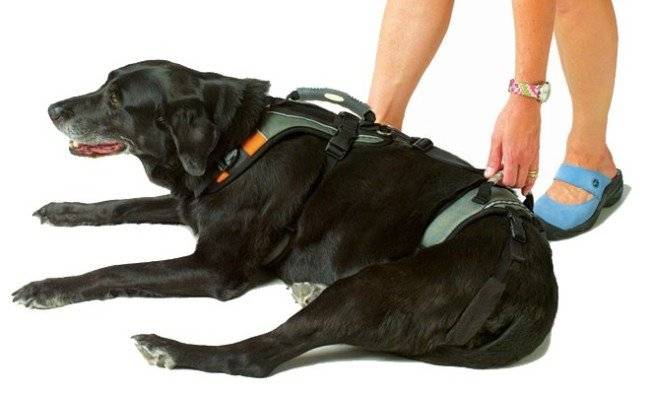
The most inexpensive among budget options Harnesses made from canvas braid are considered. This material has high strength, but its wear rate is higher. In addition, canvas harnesses are difficult to wash; the material tends to get wet and at the same time long time dries.
If you look at appearance, then definitely the most beautiful are the harnesses made from genuine leather. But it is worth considering that after getting wet, the skin loses its elasticity and may lose its shape by stretching. Once it dries, in most cases it becomes rough and its surface may crack. Leather harnesses are undoubtedly beautiful, but they are expensive and impractical.
It is not recommended to select ammunition in absentia - without a pet or only from a photograph. Only by trying it on a dog can you assess whether the product is suitable or not. Moreover, not only the size of the harness, but also the design itself may not be suitable. For the convenience of customers, most pet stores allow fitting of such products.
When is it necessary to wear a harness?
In addition to the specific needs associated with the pet's activity, there are additional situations that require wearing a harness. For example, if a dog is too active, it constantly tries to break off the leash, thereby causing injury to itself. In this case, in order not to worsen the dog’s condition and not cause additional attacks of aggression associated with pain, you can switch from a collar to a harness for a while.
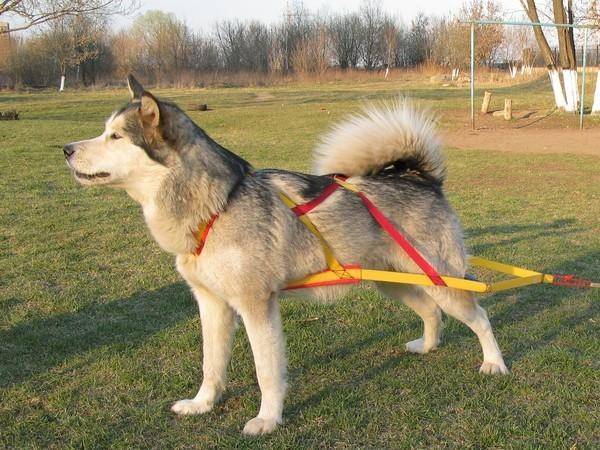
In addition, for some breeds that have a larger neck than head circumference, a collar is not a good option. Because when he tilts his head, he slides off the dog. For dwarf dogs, such as a toy terrier or, it is also more practical to use harnesses.
Dogs that naturally have a short, flat muzzle (Pikines, Petit Brabançons, Pugs, Bulldogs, Japanese Chins, etc.) have problems with the respiratory system, and collars can cause discomfort. And in this case, the situation can be corrected by using a harness, which will allow them to breathe more freely.
At what age can a dog wear a harness?
You can put a harness on a pet of small breeds starting from six months, and for larger dogs - from 8-10 months. Experts have found that getting used to such equipment too early can provoke outward deformation of the forelimbs.
The rapid development of such a pathology is facilitated by improper fastening of the harness - this happens if the belt encircling the pet’s body passes too close to the muscle cavity. This position causes discomfort to the dog, and it tries to twist its elbows to ease the discomfort. After just two to three weeks of wearing the harness like this correct positioning the paw will deteriorate. If the individual is a representative of the show class, with such a defect you will have to forget about exhibitions.
How to choose the right harness
To make the task easier, there are special tables indicating the dimensions. To use them, you need to know some dog measurements:
- Back length - measured from the withers to the base of the tail.
- Chest circumference - the correct measurement is taken in a place just behind the elbows, 1 cm is added to the resulting size for small dogs, and 2 cm for large ones.
- Neck circumference - covers the area where the collar is supposed to be.
For sledding harnesses for dogs, measurements are taken slightly different, this is due to the design feature:
- Distance from the beginning of the sternum to the withers.
- Chest length.
- The length of the segment from the end of the sternum to the base of the tail.
If the accessory is chosen correctly, it will not dangle, but it will not be able to squeeze the pet’s body. A human hand should fit under the harness.
How to put a harness on a pet
Already when trying it on, you should know how to properly put the harness on your dog. You can follow the step-by-step instructions:
- If the dog has a violent character, it must be restrained before the procedure. This can be done by holding the animal’s body in the back area between your legs.
- The harness must be straightened so that the soft surface is inside the structure.
- The ring-shaped closed part of the harness is carefully placed on the pet (its parameters vary depending on the size of the dog).
- The harness strap is positioned to the required position. If everything is done correctly, then the space between the jumper and the circular part is limited.
- Without stopping the action, you need to insert the dog's paw into the space between the strap and the closed circle.
- The jumper should slide through the pet's chest without any problems, and the harness strap will be on the right side.
- If all dressing rules are followed, then one side of the structure will be free. It must be inserted through the muscular cavity of the dog’s left paw, and then the strap is fastened.
The last step is to adjust the harness. To do this, the dog is placed on the floor, the circle on the neck is adjusted so that the straps do not put pressure on the neck, but at the same time fit tightly. After the entire procedure, you need to check whether all the mechanisms are fastened.
Of course, putting on a harness for the first time may seem complicated and time-consuming. However, as practice shows, a couple of uses and everything will return to normal, the pet will get used to it, and the dog owner will gain experience and a certain dexterity in this matter.
The pet owner decides whether to use a harness or a collar, but it is important to think, first of all, about the convenience and safety of the pet.
The harness is a convenient accessory to ensure complete control over the animal during a walk. But if the device has never been worn by a dog, its use may cause discomfort and even frighten the pet. Let's find out what you should focus on in order to choose the right harness for your dog, and how to put on this product.
What is a harness?
To figure out how to properly put a harness on a dog, it is worth considering the design of such an accessory. The device looks like a thin strap that wraps around the animal’s body in the area of the chest and shoulder blades. The harness is fastened on the neck and on the stomach. The ring from which the leash extends is located at the withers, which does not cause the pet to feel discomfort as a result of excessive pressure on the neck.
Types of harnesses
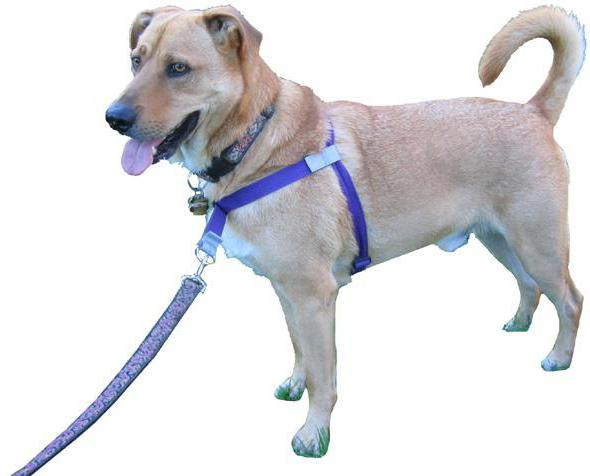 There are several types of dog harnesses:
There are several types of dog harnesses:
- Standard- represent a regular walking option. A ring for fixing the leash is placed between the animal's shoulder blades. Devices with a minimum number of belts are used for walking small dogs. For fairly large pets, standard harnesses with plenty of straps are used.
- Towing- the use of such ammunition is resorted to mainly during competitions. Harnesses of this type can be seen in dog sleds. The defining difference from the previous version is the presence of wider, more durable belts and fastenings.
- Weighted harnesses- used when it is necessary to train a pet, strengthen an insufficiently developed muscle mass. Often such devices are used during the recovery period of a pet from injuries or broken limbs.
How to accustom an animal to a harness?
Experts recommend starting to put a harness on your dog in the first months. How to put on such a device, we will consider further. Puppies more easily get used to new attributes that appear in their lives. Therefore, in this case, the harness will not cause them unnecessary discomfort.
To accustom an adult animal to using an accessory, you need to be patient. To begin with, you should put on the product at home. As soon as the dog gets used to such a leash, the owner can move on to controlling the movement of the animal. After this, it is worth practicing on the street for some time, choosing places for this without people, other animals and public transport.
How to put a harness on a dog: step-by-step instructions
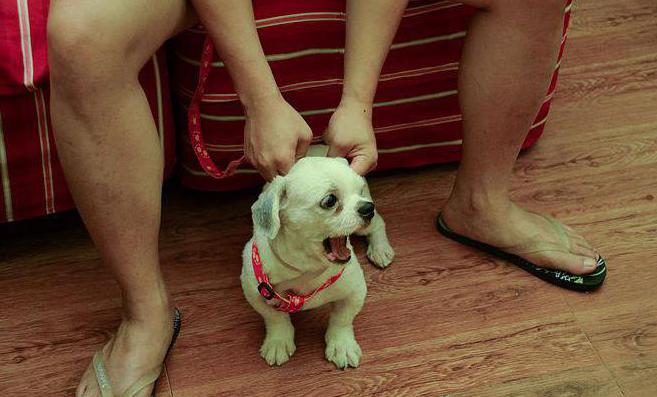 To quickly prepare your animal for a walk using a harness, you should use the following recommendations:
To quickly prepare your animal for a walk using a harness, you should use the following recommendations:
- How to put a harness on a dog? The scheme involves straightening the leash so that its soft part is located from the inside. If the animal resists, you need to squeeze its body between your legs.
- The top and bottom loops of the harness need to be placed on the dog's head. In this case, the supporting, vertical strap should be located in the animal’s chest area.
- On the side of the loops that are already on, there are several straps where you need to thread your pet’s paws. The ends of the paw straps should be connected with a buckle.
- At the end, it is enough to adjust the harness, make the necessary adjustments, tightening the fasteners and fastenings. Before taking your pet for a walk, it is worth checking whether the harness can be removed over the head. You also need to evaluate the reliability of fixation of the elements where the animal’s paws are inserted. If the harness falls off, you should tighten the fastenings more tightly. Ultimately, the front strap should be located in the pet's chest area, and the D-ring for the leash should be located between the shoulder blades.
How to make this accessory yourself?
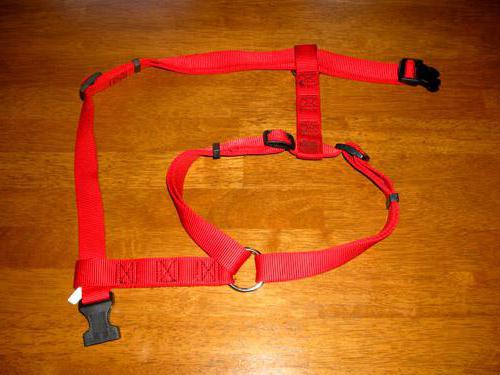 If you wish, you can try to make a harness for your dog with your own hands. It will be much easier to figure out how to wear an accessory you made yourself. During the work you will need the following tools and materials:
If you wish, you can try to make a harness for your dog with your own hands. It will be much easier to figure out how to wear an accessory you made yourself. During the work you will need the following tools and materials:
- nylon sling about 30 mm wide;
- material for making lining in the form of flannel fabric or felt;
- steel rings;
- snap-lock buckle;
- strong threads;
- scissors;
- sewing machine.
To make a harness, it is better to use solid steel rings. If these structural elements contain slots, the latter may unbend during strong jerks. It is worth choosing rings into which you can freely stretch several loops from the slings.
How to make a harness for a dog, how to put on such an accessory? To begin with, it is worth taking measurements of the animal’s body parameters. The circumference of the chest should be measured behind and in front of the pet's limbs. Next, determine the distance between the dog’s shoulders.
The work begins with cutting out the lining. The material, folded in half, is placed on slings that will pass in the animal’s chest area. Nylon slings are sewn together with the lining. Using scissors, all excess parts are carefully removed, and the edges are machine stitched.
The buckle-lock is attached to the slings in the chest area of the animal. Additional length of material is provided to allow for adjustment. The ring for the leash is sewn on the top of the product. It is desirable that the latter is ultimately located exactly between the pet's shoulder blades.
During assembly of the device, it is recommended to periodically put it on the animal, making the necessary adjustments. This will ensure not only a comfortable fit of the product on the dog, but also ensure that the four-legged friend does not escape during a walk.
Finally
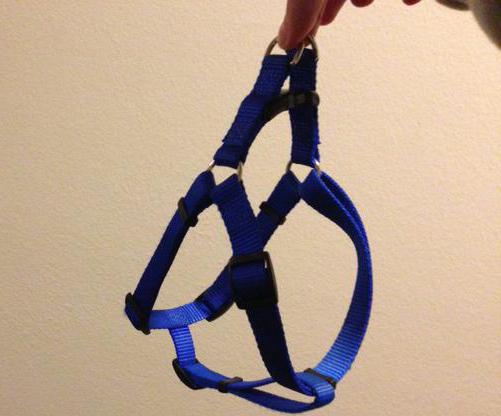 So we looked at how to put on a harness. The instructions suggest holding the dog tightly during this procedure. A product that is suitable in size will not only provide complete control over the animal during a walk, but will also make wearing the accessory the least uncomfortable for him. Proper use of the harness does not make you worry about the safety of your four-legged friend and allows the animal to explore the world around it.
So we looked at how to put on a harness. The instructions suggest holding the dog tightly during this procedure. A product that is suitable in size will not only provide complete control over the animal during a walk, but will also make wearing the accessory the least uncomfortable for him. Proper use of the harness does not make you worry about the safety of your four-legged friend and allows the animal to explore the world around it.
The cat often does not respond to given name or the owner's call. During a walk, this animal, succumbing to curiosity, immediately begins to explore the area or hides in secluded places. That’s why it’s better to put a harness on your cat outside.
The use of this accessory will protect the animal from being run over by vehicles. During long trips, the use of the product is necessary.
Externally, the accessory is a thin belt that is put on the cat. Fasteners are placed on the pet's neck and chest. The ring is on a strap, located above the shoulder blades, and a leash is attached to it.
This design allows you to avoid pinching the thin neck and will protect you from injury. Some types of accessories are equipped with a collar. A DIY cat harness will help you save money on purchasing an accessory and add a stylish item to your pet’s wardrobe.
What do you need to know about the harness?
- The size of the product is selected in accordance with the parameters of the animal. One finger should fit between the straps and the cat's body. If the gap is larger, the cat will be able to jump out of the harness.
- Before using the accessory for the first time, give the cat a sniff. This way she will get used to the new thing faster.
- A kitten is taught to use a leash from two or three months of age. Kids adapt to new things more easily, so as adults they are more likely to get used to walking on a leash.
- An adult pet is taught gradually. The accessory is put on for a couple of minutes, gradually increasing the duration of walks. First, the animal is taken to deserted places. Only after complete adaptation can a pet be taken out onto a busy street with moving vehicles.

DIY cat harness. Step-by-step instruction

Option No. 1. Jeans harness
It is better to use a jeans belt. But you can also take pant panels.
- Measurements are taken from the kitten. To do this, make a girth around the neck, as well as under the chest of the kitten. When measuring, they insert it under the measurement forefinger so that the future harness does not pinch the animal. Make an allowance of 0.5 centimeters on both sides.
- Cut the strips according to the measurements. To connect two strips together, a third element is cut.
- The parts are sewn together by hand using short stitches. The thread is selected in accordance with those used to sew the jeans.
- The two harnesses are connected to each other by jumpers. Sewn on.
- They cut the leash. Its width should be at least 3-5 centimeters. Optimal length for walking 1.5 - 1.8 meters.
- A button is installed on the edge of the leash, and a rivet is placed 6-7 centimeters closer to the center of the leash. Having passed through the jumper, the leash is secured using a button and a rivet.
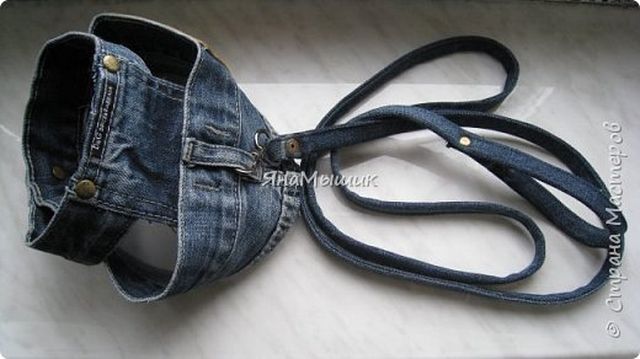
The leash for walking is ready. A denim leash will add variety to your pet's wardrobe.
DIY cat harness. Option No 2
Necessary materials:
- Thin leather straps. You can use a flat nylon rope.
- Buckles.
- Rings.
- Carbine.
- Thick needle.
- Scissors.
- Awl.
- Strong threads.
The design is created in the form of two belts covering the pet’s neck and body. They are connected to each other by a special strip. A leash is attached to the jumper or one of the straps. The design is secured with a buckle and carabiner.
- Measurements are taken from the animal. Neck and chest measurements are taken.
- Cut off two pieces of the strap, making allowances of 2 centimeters. The third piece is needed to create a jumper bar.
- Cut off 1.5 - 1.9 meters of the strap. This will be a DIY cat leash. A carabiner is attached to one end, the other is bent in the form of a loop, into which the owner’s free hand can enter. The loop is stitched.
- If a flat rope is used instead of a strap, its ends are burned with fire.
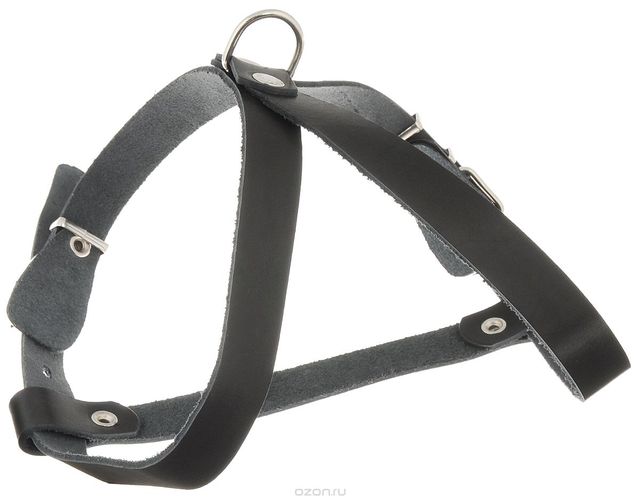
Option No 3
Necessary materials:
- A piece of raincoat fabric.
- Fleece fabric.
- Rubber.
- Strap.
- Braid.
- Decorating ribbon.
- Lock.
- Fastening elements.
- Decor.
- Roulette.
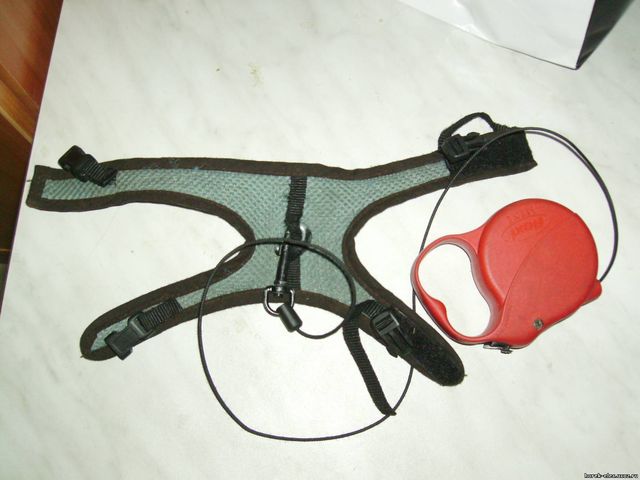
Instruction:
- A sketch is drawn on a piece of notebook paper. You can draw the parameters for the finished accessory.
- The pattern is transferred to raincoat fabric and fleece.
- The place for the braid is marked on the fabric and stitched.
- A braid is attached along the spine and a loop is left. A ring is threaded through it. It is needed to secure the leash.
- The neck is made from raincoat fabric. An elastic band is sewn onto it, collecting the fabric. You can use braid for decoration.
- The neck is attached to the base. The edge is folded. During sewing, it is necessary to try on whether the design will put pressure on the animal.
- Assemble the fastening parts. Straps are inserted inside, attached, the edges are processed and stitched. The product is put on the cat to adjust the length of the belt.
- Decorate the base. The product is decorated with bows, stones, rhinestones - to your taste. Braid and decorative tape are attached along the edges.
- The harness is put on the pet. The leash is attached to the ring.
In what cases is the use of a harness prohibited?
- If an animal is not vaccinated, veterinarians prohibit it from walking outside. A cat can catch the disease from street animals.
- It is not recommended to take small kittens outside. The immunity of children is not sufficiently developed.
- It is difficult to train cats over 10 years old to wear a harness. They do not recognize an accessory made even from things that are familiar to them. Therefore, it is better to walk them in sparsely populated or deserted places.
- It is not recommended to walk pets with a harness after illness, surgery, or pregnant cats.
- If a cat is terrified of a leash or begins to behave aggressively at the sight of a harness, you should not try to force train it.
There are several types of dog harnesses. Some are divided by categories of use. Others – based on the materials used. Still others - by size, etc. Harnesses are ordinary for walking dogs, tie-down, guard, sledding, and special. Each of them is useful in certain situations. But we are more interested in ordinary harnesses. They are needed to evenly distribute the load on the chest if the dog strongly rushes forward. Most often, leather, nylon and leatherette are used as harness materials. Let's look at how to properly put a harness on a dog so that it and its owner are as comfortable as possible.
8 231582
Photo gallery: How to properly put a harness on a dog
How to put a harness on a dog: diagram
Area of application of harnesses
Harnesses are the best alternative collars. Anyone who has owned dogs knows that collars can cause serious neck injuries. For example, when a dog suddenly rushes to the side or is pulled back by its owner. Microdisplacements of the vertebrae of the neck and back occur, which in the future causes pain and developmental defects. Sometimes the thyroid gland is injured. In addition, a tight collar interferes with breathing.
Harnesses consist of several straps that cover the dog's body on the chest and under the paws. If the harness is sized, it evenly distributes the load during jerking. In addition, the areas of the body where the harnesses are fixed are less prone to injury.
They start using harnesses while walking with puppies. First, they get used to the extra ammunition. And secondly, they don’t squeeze on collars with leashes, trying to wriggle to the side. Harnesses are even recommended for puppies of some breeds due to their skeletal structure. Typically they are stocky strong breeds with thick necks: Amstaffs, Boxers, Bulldogs, Rottweilers and the like. Harnesses are also recommended for dogs of miniature breeds to protect their fragile skeletons.

Keen dog breeders also use special harnesses as a matter of duty: for training dogs to search by smell, for training, towing harnesses, weighted harnesses, sled harnesses, etc. Ask why they are used ordinary family? In fact, there are quite a lot of applications. For example, towing harnesses will be useful for fans of active sports. Of course, only a few take part in dog sled competitions. But with the help of a tow harness, a strong dog can easily give a skier a ride. And the sled harnesses are conveniently attached to regular sleds. If you trust the dog, then it will be happy to give the kids rides in the winter. Weighted harnesses are an excellent exercise machine for strengthening the muscular system. However, before using them, you need to consult with specialists: a veterinarian about contraindications, and a dog handler about the training regimen.
How to wear a harness correctly
To properly put a harness on a dog, you need to choose it correctly. To do this, measure the dog's chest circumference. The size of the harness is determined according to the table. Naturally, there will be no ideal values. Therefore, the sizes of harnesses are given with variations: from maximum to minimum. After all, the length of the straps is adjustable within the indicated limits:
| Belt width in mm | Chest coverage from max to min (cm) | Dog breeds |
||
| Leonberger, St. Bernard, Newfoundland, Great Dane |
||||
| Doberman, Weimaraner, German Shepherd, Rottweiler |
||||




